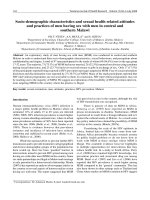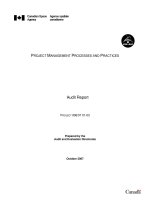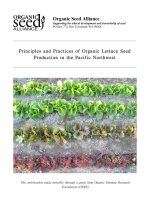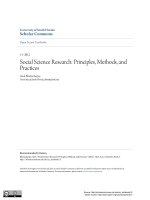religious beliefs and practices
Bạn đang xem bản rút gọn của tài liệu. Xem và tải ngay bản đầy đủ của tài liệu tại đây (337.05 KB, 20 trang )
Table of Contents
I/ Introduction………………………………………………… 2
II/ Historical Background………………………………………3
III/ Religious Beliefs and Practices…………………………….4
IV/ Architecture, Statues and Altars……………………………5
1. Architecture……………………………………………… 5
2. Statues and Altars……………………………………… 9
V/ Heroes, Legends and Festivals………………………………15
VI/ Advice for Visitors………………………………………….16
VII/ List of References……………………………………… 18
I. INTRODUCTION
In recent years, Vietnam has become one of the most famous
destinations in the world. Every year, there are many foreign tourists
traveling to Vietnam. They visit Vietnam for many purposes such as:
business, vacation… but as we see their main purpose is learning about
Vietnam culture or visiting some famous landscapes in Vietnam. And
especially, many of them like visiting pagodas in Vietnam.
1
In Asia countries, pagoda is a very special and sacred place. It makes
people who come to visit pagoda feel very safe, peaceful. And if they can
understand about the pagoda where they visit, it will be more interesting.
That is the reason why we write this report. This is also a good chance for us
to know more about pagoda, about language which is used to talk about
pagoda. It is very useful and good for our job in the future. After finishing
this report, we also know how to organize information in the report, and
especially our English writing skill has improved very much.
So we would like to thank our teachers very much who gave us this
project and helped us this project successfully.
As you know, in Vietnam, here are so many pagodas, people can visit
pagoda in every province with many sizes from small to very large. Some
pagodas are very famous such as: Perfume pagoda, Kim Lien pagoda, Ba Da
pagoda, Tran Quoc pagoda… Numbers of tourist come to see these pagodas
is very high.
But in this project, we would like to introduce to you one pagoda
which is not very famous but it is very beautiful and ancient, it is Thien Nien
pagoda, located in Trich Sai village, Buoi Guild, Tay Ho district, Hanoi.
We choose this pagoda because two main reasons:
- We had some chances to visit Thien Nien pagoda. It is very large,
ancient. It is not so far for us to come.
- We have read some interesting information about this pagoda and it
makes us confident to discover carefully.
Thien Nien pagoda was recognized as a historical and cultural site by state in
31
st
, January, 1992.
2
II. HISTORICAL BACKGROUND
Lying on the bank of Ho Tay and hiding under the shade of ancient
trees, Thien Nien pagoda is a pagoda which was considered to be the most
beautiful and ancient pagoda in the west of Thang Long Citadel.
According to history of this pagoda, in the past, West Lake area is a
stone wood forest. There was a fox with nine tails living in a small mountain
in the forest. It always appeared to disturb domestic animal and people.
King Ly Nam De was very worried about this problem and decided to
send two princesses on learning miracles to kill the fox. On the way to learn
miracles, two princesses met a saint who is named Huyen Thien Hac De (the
King of black cloud and rain). He knew the aims of them and decided to
help them.
After 100 days, two princesses had mastered miracles, they killed the
fox. So that, after they died, King Ly decided to build this pagoda to
dedicate two princesses.
The official name of the pagoda is Thien Nien but local people
nowadays call it Trich Sai pagoda because it is located in Trich Sai village.
Thien Nien pagoda was built under the reign of King Ly Nam De in the
sixth century. Fifteenth centuries has passed, the appearance of the pagoda
has changed a lot after many restoration and repairs. But Thien Nien pagoda
as you see today is the result of a big restoration undertaken in the middle of
the 19
th
century. However, from 15
th
century until now, it was rebuilt many
times especially in 2002 with the surrounding walls and all names of people
who helped to rebuild pagoda were written on the stone stele in pagoda.
3
This pagoda is very large. It covers area of about 10000 m2. It is
surrounding by many big trees and lies on the bank of West Lake. It is very
pleasant for people coming here.
Inside the pagoda, there is a small bell. It was castled in 1862 (under
the reign of King Minh Mang) and 41 statues are kept inside pagoda.
III. RELIGIOUS, BELIEFS AND PRACTICES
As you know, Buddhism had its origins in India, it was founded by a
crow prince Siddhartha.
The main idea of Buddhism is to help people to get away from all
sufferings of the life, to go to Nirvana.
Buddhism was introduced into Vietnam through two ways: from
China and directly from India. Buddhism was accepted by Vietnamese
people after having some changes and popularized by blending with the
traditional beliefs.
Since then, Buddhist pagoda and temple appeared in different times
and different places until every village had its own temple. That is the reason
why nowadays there are many pagodas in Vietnam. By searching these
pagodas, we can not see all the characteristic features of Buddhism, religions
and beliefs in Vietnam. But this will help us understand an important aspect
of the cultural and ideological history of Vietnam.
In Thien Nien pagoda, besides Buddha, people also worship Mother
Saint, Gods and some Monks. Twice per month on the 1
st
and 15
th
of lunar
month, people go to pagoda and temple. They bring offerings such as fruits,
joss-stick… to pagoda and put them on altars. They pray Buddha for their
family, their health, good luck come and avoid bad things.
4
In some occasions, they organize festivals, like Vu Lan festival. In
this festival, they pray for dead soul to be free from sufferings. Besides Vu
Lan festival, Thien Nien pagoda also organize Phat Dan festival (Great
Buddha’s birthday) on the 8
th
of the 4
th
lunar month. In this festival, they use
5 scent water (prepare from different flowers and plants) to pour the
Buddha’s body.
Everyday, as well as in some festivals, all monks in Thien Nien
pagoda say prayers to hope that they will understand Buddha’s theory and be
relaxed. Moreover, they pray to Buddha to bring good health and luck for
everyone.
IV. ARCHITECTURE, STATUES AND ALTARS
1. Architecture
Thien Nien pagoda is arranged in the form of the letter “I” surrounded
by rectangular structure of brick walls. This kind of shape is called “Noi
cong ngoai quoc” which is very popular in the North of Vietnam.
As many Vietnamese pagodas, this pagoda includes 3 parts: three
door gate, courtyard, main hall. The three door gate plays an important part
in each pagoda in Vietnam. This gate is divided into 3 ways of entrance.
Number 3 is odd number. In Vietnamese culture it symbolizes for breed and
happiness. At the roof of three door gate, there are 4 dragons at 4 sides.
According to Vietnamese culture, dragon is one of sacred animals. It
symbols for power of the King and property.
Pagoda is covered with tiles, usually in two layers. The tiles are
shaped like the blade of a big knife. Together, all those tiles look like a lotus.
The symbol of the lotus is widely used in pagoda because of its strong
5
character. Most of the rafters of a pagoda are carved with pictures of dragons
and phoenixes or sometimes flowers.
The main color used in pagoda is brown because it helps create a quiet
and peaceful atmosphere.
The inside pagoda is comprised of three main rooms:
- The 1
st
room of the pagoda is called Bai Duong (place for bow -
towing admiration). In Bai Duong, there are two statues of guardian spirit
(Hộ pháp) or general officials to protect pagoda and Buddha. The two
statues are very big and made of terracotta. The one with the white face is
called Ong Thien (the saint who encourages people to do good and kind
things). The other with the red face and big knife in his hand is called Ong
Ac (the saint who punishes those who do bad and cruel things). A part from
that, there are statues of God and Saint-monk.
- The next room is small room called Ong Muong (Tube room). From
Ong Muong there is a system of statues. Statues of Buddha are placed on
pedestals with the shape of lotus blossoms. The pedestals are carved with
pictures of dragons, waves and flowers that reflect a stable and prosperous
society. This is lead to Thuong Dien (higher temple).
-The last room of the pagoda is Hau Duong (Back room). The room is
used to worship goddesses: Mau Thuong Ngan (Mother goddess of
mountain), Mau Thoai (Mother goddess of water), Mau Thien (Mother
goddess of heaven).
In order to make readers understand more about Thien Nien pagoda,
we use diagrams and picture to explain.
9 9
6
8
7
9 9
5
10
4
3
7
6
1 10
2
Diagram of Thien Nien pagoda
Note
1. The main gate leading to pagoda
2. Three door entrance
3. Courtyard
4. 5. 6. Main Hall
4. Place for bow-towing administration
5. Tube house
6. Back room
7. The house where monks live
8. Area of relic stupas of the patriarchs
9. Garden
10. Brick wall
2. Statues and altars
In the main hall: in this part we would like to describe how people put
statues and altars in the main hall.
8
9
7
1 2 3
4 5 6
8 9
1
0
0
1
1
1
2
1
3
1
5
1
4
1
6
1
9
1
9
18
18
18
18
18
17
17
17
17
17
Status system in Thien Nien pagoda
Note
1, 2, 3: The trinity of Buddhas (Phat Tam The)
4. Avalokitesvara holding her baby (Quan Am Tong Tu)
5. Buddha of the past (Phat Adida)
6. Goddesses of Mercy (Quan Am Bo Tat)
7. Buddha of the present (Tuong The Ton Thich Cao or Thich Ca
Mau Ni)
8. Thap Diep
9. Ananda
10. King of Heaven (Ngoc Hoang)
11. Nam Tao
12. Bac Dau
13. Phat Nhap Niet Ban
14. New-born Buddha (Thich Ca So Sinh)
15. Pho Hien Bo Tat
16. Van Thu Bo Tat
17, 18. Ten King of Heaven (Thap vi Diem Vuong)
10
2
0
2
0
19. Guardians (Ho Phap)
20. God
21. Saint- monk
Altars of goddesses:
1
White statue
2
Red statue
3
Green statue
1. Mother Goddesses of Water (Mau Thoai)
2. Mother Goddesses of Heaven (Mau Thien)
3. Mother Goddesses of Mountains (Mau Thuong Ngan)
Besides that, in Thien Nien pagoda there are many other statues, all of
them are made of wood.
As Mr Thich Nguyen Duc (resided monk) said there are many statues
in the main hall as well as in Thien Nien pagoda. So we would like to
introduce to you some main, famous and oldest statues.
a) Buddha of the present (Phat Thich Ca Mau Ni)
11
This was a real person. His name is Siddharrtha. He was a crow
prince, the son of King Tinh Phan. He was born around the year 563 BC in
the Lumbini garden of capital Kapilavastu (now located in southern Nepal at
the foot of Hymalayas). Sakyamuni was name given to him by his disciples.
It means “a quiet sage of Sakia race”. He chose to leave his family, rich life
and lead a simple life at the age of 29 although he got married and a son. At
the age of 35, after meditating at the foot of Bodhi tree free for 49 days, he
received enlightenment as to the path of deliverance. He died at age of 80.
His body was fired and after that is was divided in many parts to share for
many countries. These countries built pagoda and towers to worship
Buddha.
b) The new-born Buddha (Thich Ca So sinh)
This is also a very famous statue. According to Mr Thich Nguyen
Duc, this is the oldest statue in Thien Nien pagoda. It was curved in 15
centuries. Look at this statue we can see that is a small boy, wear skirt. He
stands on a lotus flower. People said that after he was born, he steped 7
steps, he left hand point land, his right hand point sky and said: “On the
heaven, in the earth, only me should be respected” (Thien thuong dia ha duy
nga doc ton). And at that time there were 9 dragons from heaven poured
water on his body.
c) The trinity of Buddha (Phat Tam The)
These statues are placed at the highest position of the main hall. They
are statues of the past (on the right side), present (in the middle) and future
Buddha (on the left side).
They are very smooth and relaxed. Especially, the statue of the
present does meditation.
d) Parinirvana (Phat Nhap Niet Ban)
12
You can see this statue at the lowest position of the main hall: Buddha
is laying, it means that: Buddha is staying at Nirvana- a very perfect place
for people and all people who follow Buddhism want to reach. In some
pagoda, this statue is very big, but in Thien Nien pagoda it is small.
e) Goddesses of Mercy (Quan The Am Bo Tat)
She is the greatest and most powerful Buddha in Vietnam. Some
statues describe her with two hands but others describe her with thousand of
hands and eyes. It means that she can see and know everything happening in
the world and help in time. Legend has it that: the Goddesses of Mercy was
born into a poor family and upon reaching adulthood, dutifully obeyed her
parents and married a student called Thien Si. One day, she made a very
small mistake and she was forced to leave the house. Feeling very
disappointed and sad, she sought refuge in a pagoda and stated a religious
life where she got the name Kinh Tam.
f) Kings of Hell (Thap Dien Diem Vuong)
There are ten statues of King of hell. Each side has 5 statues. They are
Kings who keep 10 doors in the hell. Their duty is to command all deal
souls, so the can know who is bad person or good one. Because in
Buddhism, people believe in a life after they die, so if they are good person
they will get a good life in other world. And of course if they are bad person
they will get a very terrible life in other world, even they can be animal.
These statues mean that: they advise people should do the good things and
avoid doing bad things.
g) Mother Goddess of Water (Mau Thoai)
She wears white shirt. Because Vietnam is an agriculture country, so
water is very necessary, it is the most important element. Without using
13
water, farmers can not do their work, so they can not exist. That is the reason
why people want to worship Mother Goddess of Water.
h) Mother Goddess of Heaven (Mau Thien)
She wears red shirt. In the past, Vietnamese people used to worship
the fire and sun. Because the fire and sun help them cook their food, avoided
cold weather, she brought the light to the world. That is the reason why they
worship her. Her statue is placed in the middle of the altar.
i)Mother Goddess of Mountain (Mau Thuong Ngan)
She wears green shirt. People worship her because they want to show
their respect to the tree. In the past people were depended on nature. They
earned for their live by picking fruits or killing animals in the mountains.
They believed in the heaven with the hell and the earth. The sacred tree of
Buddhism is Bodhi-tree.
V. HEROES, LEGENDS AND FESTIVALS
According to resided monk (Mr Thich Nguyen Duc), this pagoda was
built to dedicate to two princesses who had great merit, having helped King
Ly kill the fox with 9 tails.
14
However, he and most of local people do not remember (in fact they
don’t know) the name of two princesses because the pagoda was built too
long ago (in sixth century).
What about festival, there are some festivals are organized in this
pagoda such as: Vu Lan festival, Thuong Nguyen festival, Phat Dan festival.
However, they could not organize too big because local people have not paid
attention to pagoda and pagoda has not many followers.
1. Vu Lan festival
Vu Lan festival is organized on the 15
th
of the 7
th
lunar month. It is
very important festival. In this festival, all monks in Thien Nien pagoda
prepare rice, fruits, paper clothes, gruel (they pour gruel on banyan leaves).
After praying for the dead souls (who has no family) to be free from
sufferings, they throw gruel and rice everywhere and they fire paper clothes.
This action means that, they give food and clothes to dead souls, because
people think that the life in the hell is same with our life, so the dead souls
also need all things people need. This ceremony is also called the feeding
ceremony.
2. Thuong Nguyen festival
This festival is held on the 15
th
of the 1
st
lunar month. People believe
that, in this day, Buddha will come to pagoda so this time is a chance for
people showing their respect to Buddha. People come to pagoda to pray
what they want. Monks in pagoda say prayers and tell the story which
associated with Buddha. This is the most important festival in pagoda, so
although people are very busy, they still spend time to come to pagoda this
day.
3. Phat Dan festival
15
In this festival, monks often use five scent water (prepare from
different flowers and plants which grow in the garden) to boil. After that,
they use that water to pour on the Buddha’s body.
4. Other festivals
Beside some main festivals in Thien Nien pagoda, Monks also
organize other festivals. They are:
- On the 1
st
of the 4
th
lunar month: festival welcome the summer
season.
- On the 1
st
of the 7
th
lunar month: festival say good bye summer
season
- On the 21
st
of the 4
th
lunar month and the 19
th
of the 9
th
lunar
month: Monks’ death anniversary.
VI. ADVICES FOR TOURISTS
Thien Nien pagoda is located on Trich Sai village, on the bank of
West Lake. So it is very easy to get to this pagoda. Tourists can get to Thien
Nien pagoda by car, by motorbike, by bicycle, by bus… If you want to visit
Thien Nien pagoda it is very simple. When you reach Cau Giay cross roads
(near the main gate of Thu Le zoo) follow Buoi street and Hoang Hoa Tham
street about 3 km you will see the pagoda on your right hand surrounded by
a yellow brick wall.
Hoang
Cau Quoc
16
Giay Viet
Str. Str.
Lang str. Buoi str. Lac Long Quan str.
Giang
Vo
Str.
Apart from that, there are many ways to get this pagoda.
According to Mr Thich Nguyen Duc, Thien Nien pagoda always
opens the door to welcome all people. Tourists do not have to buy ticket or
do not have to give money when they come to pagoda.
On the 1
st
and 15
th
day of lunar month or on the festival days of
Buddhism, the pagoda opens all day (from 7 am to 9pm). On other days, it
opens from 8am to 5pm.
If tourists want to get information, they can meet monks to ask
because monks are very friendly or tourists can read information inside the
pagoda.
Tourists should not wear short clothes, skirt because pagoda is very
sacred place. During the time tourists visiting pagoda, they should talk
17
Thien Nien
Pagoda
loudly, laughing or say bad words, it is so rude. Lastly, before visiting
pagoda, tourists should ask monks for permission.
VII. REFERENCES:
1. Mr Thich Nguyen Duc, the resided monk of Thien Nien pagoda.
2. Mr Nguyen Do Bao, teacher of Vietnamese cultural history.
3. Some local people
4. Some relevant documentaries.
5. English for Tourism textbook HD4, Faculty of Tourism, Hanoi Open
University
6. Vào Chùa thăm Phật – Trần Nho Thìn
7. www.dulichachau.com
8. www.lichsuvietnam.info
9. www.vitinfo.com.vn
10. www.vnexplore.net
11. www.wikipedia.org
18
Guardian
Ten King of Heaven
19
The new-born Buddha
20









